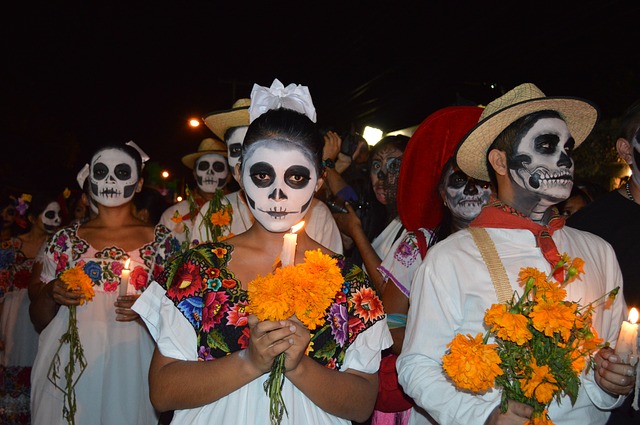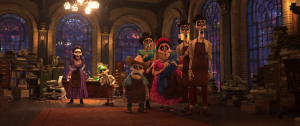 I recently spoke at the Deliverance Ministry Workshop, hosted by the Missionaries of the New Evangelization in Castle Rock, Colorado, and was explaining why the very non-Christian version of the Day of the Dead featured in the Disney movie, Coco, was a non-starter for both kids and parents. Afterward, a Hispanic man schooled me on exactly why this this feast is okay when celebrated the Christian way.
I recently spoke at the Deliverance Ministry Workshop, hosted by the Missionaries of the New Evangelization in Castle Rock, Colorado, and was explaining why the very non-Christian version of the Day of the Dead featured in the Disney movie, Coco, was a non-starter for both kids and parents. Afterward, a Hispanic man schooled me on exactly why this this feast is okay when celebrated the Christian way.For those of you who aren’t familiar with it, the Day of the Dead, or Dia de los Muertos, is celebrated between October 31 and November 2 and coincides with the Catholic holy days of All Saints and All Souls. Although largely Mexican, it is particular to Latin American populations and blends together several cultures and traditions. During this celebration, Christians visit the graves of their relatives to decorate and clean the sites.
However, this is not the version of the Day of the Dead that was highlighted in the Coco movie. Instead, the film glamorized the indigenous roots of the holiday which assert that the dead come back to life at this time of year. In the movie, the main character, Miguel, is punished for stealing a guitar from the grave of a famous Mexican musician, which causes him to be taught a lesson by the dead who transport him to the Land of the Dead. This is far from a heavenly place. Instead, it’s inhabited by skeletons who go to movies, drink, play games, and otherwise indulge in very worldly activities. “Spirit guides” take on different forms during the movie and pagan belief systems are put forth such as how the dead are annihilated and fade into dust when no one remembers them any more – as if our eternal life depends on the affections of our relatives.
In short, the film is nothing more than a well-packaged pagan worldview for kids.
The problem is that it misrepresents the Day of the Dead by depicting only the pagan roots of this holiday and not the way it has evolved since the advent of Catholicism into the culture.
The roots of the Day of the Dead can be conclusively traced back to the time of the Aztecs but may date as far back as the Olmec civilizations which thrived from 1200 to 400 B.C. These pagan cultures celebrated the Day of the Dead for a month (from mid-July to mid-August). The Aztecs believed the time was presided over by Mictecacihuati, the Lady of the Dead, and Huitzilopochtli, the god of war. They believed the earth was a “force” of death that had to be constantly satiated with human life and were known to sacrifice as many as 250,000 people a year in order to appease this “force” and the hunger of other deities.
 The Day of the Dead was celebrated throughout central America in its original pagan form until the conquistadors brought Catholicism to the area. The practice was then shortened from a month to the same two days the Church has set aside to honor the dead, namely the feast of All Saints and All Souls. Many people celebrate the Day of the Dead by attending Mass and visiting the graves of their dead.
The Day of the Dead was celebrated throughout central America in its original pagan form until the conquistadors brought Catholicism to the area. The practice was then shortened from a month to the same two days the Church has set aside to honor the dead, namely the feast of All Saints and All Souls. Many people celebrate the Day of the Dead by attending Mass and visiting the graves of their dead.
Not surprisingly, the Coco movie completely ignored the seismic impact on the culture – and its Day of the Dead celebrations - that occurred as a result of the appearance of Our Lady of Guadalupe to St. Juan Diego in the 15th Century. This appearance led to the conversion of millions of Aztecs and, subsequently, the cessation of the rampant human sacrifice in that culture. Estimates range of anywhere between three and nine million souls that were converted in the wake of this event, enough to decidedly change how the Day of the Dead was celebrated in that country. No longer was it just a pagan feast but it was now a special time for family and friends to gather and remember their deceased loved ones and to pray for God’s mercy upon their souls.
As Katherine Ruddy writes for Aleteia: “All Saints Day and the Day of the Dead are a multi-day holiday event in Mexico and a time for family and friends to gather and celebrate the lives of the deceased. Private home altars (ofrendas) are constructed to display photos of departed loved ones, sugar skulls (calaveras), and vibrant flowers. Families will also visit cemeteries and bring food and drink offerings that the deceased would have enjoyed while they were alive. Everyone will enjoy pan de muerto (bread of the dead). And for the finale, tens of thousands participate in lively street processions (desfiles) featuring music and dancing, magnificent costumes, and, of course, the iconic Calaveras Catrinas (elegantly dressed skeleton ladies, based on a 1910 engraving by Mexican artist José Guadalupe Posada).”
According to Catholic Online, “The skull is a common symbol of the holiday and it is common for women to paint all or one-half of their face with a skull. The half-skull painted on the face, particularly of a youthful woman, represents the brief transition between life and death.”
Some believe that the custom of leaving a deceased loved one’s favorite foods and beverages out on a table or altar in the home or beside the grave indicates acceptance of the pagan belief that ancestors can come back from the dead. However, there is a much deeper reason behind this custom.
As Catholic Online explains, “The intent is to encourage visits by the souls, so that the souls will hear the prayers and the comments of the living directed to them.”
In other words, these practices are meant to invoke the dead – which means to ask them to pray for us. Evoking the dead, as would be done by a medium, demands that a deceased person appear and/or communicate with them in some way.
For Christians, the meaning behind this celebration could not be further from the pagan worldview.
“The Day of the Dead calls upon the Catholic understanding of death as having been vanquished by Christ, and through his conquest, the door to eternal life. Thus, it is a reminder that all of life on earth is really a preparation for death, and that in death, we will be reunited with all those who have gone on before us to eternal life,” Ruddy reminds.
I don’t blame that kind gentleman for being upset with the way Hollywood portrayed such an important and precious celebration in the lives of Christians.
Although the advent of Halloween and the upcoming holiday season brings out the usual recounting of myths about how Christian feasts are just repackaged paganism, this man’s ire reveals the truth – the Day of the Dead may have derived from paganism but the Christian version thoroughly replaced it and deserves to be treated as the distinct holiday that it is. .
© All Rights Reserved, Living His Life Abundantly®/Women of Grace® http://www.womenofgrace.com
Our New Age Q&A Blog is now 10 years old and going strong! It is only with your prayers and donations that we have been able to help so many souls around the world. Thank you for your support!
